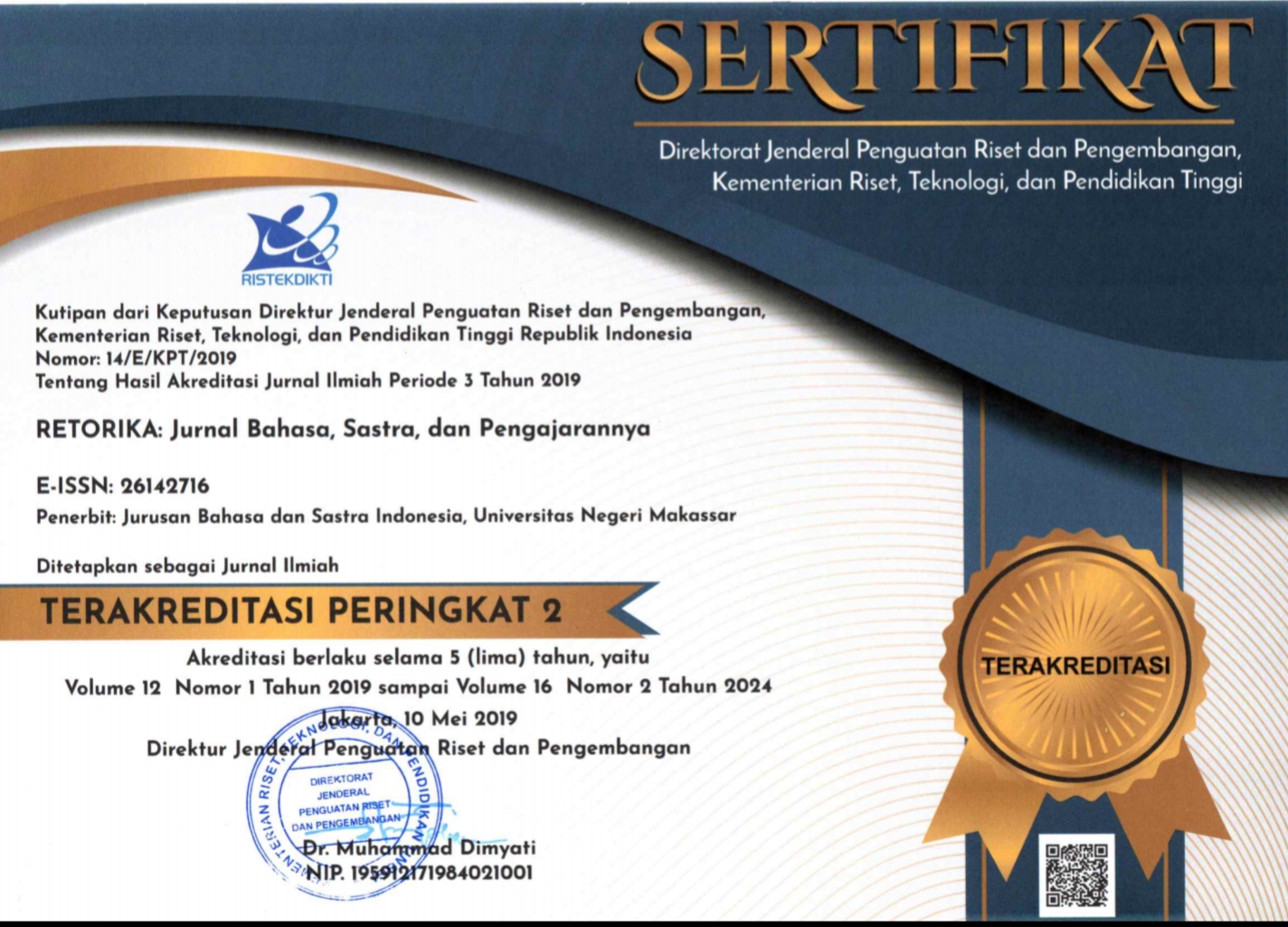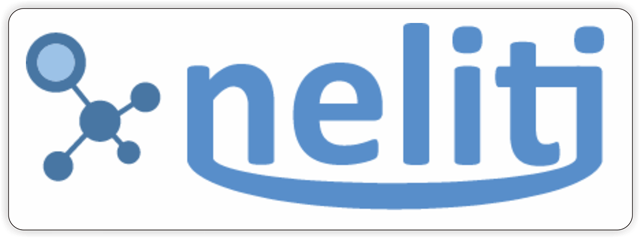DRAMATIZATION STRATEGY AND JUNIOR HIGH SCHOOL STUDENTS’ READING MOTIVATION
(1) Universitas Pendidikan Indonesia
(*) Corresponding Author
DOI: https://doi.org/10.26858/retorika.v14i1.18877
Abstract
This study is motivated by many expert opinions which state that the students' reading motivation in Indonesia still needs to be increased. The researcher tries to answer the problem by trying out a Dramatization Strategy in reading learning with the aim of increasing reading motivation. This strategy is carried out by developing students' cognitive and metacognitive abilities. The experimental method with a factorial design is chosen to determine the effectiveness of the Dramatization Strategy, either for readers with high- or low-level reading comprehension. The data sources of this study are 101 students of Madrasah Tsanawiyah in Bandung Regency and Bandung City. The results of the study show that the Dramatization Strategy is effective in increasing reading motivation, especially for improving reading skills and for social interaction. The implication of the study is the need for the application of the dramatization strategy by adjusting the teachers’ insights and abilities in identifying students' reading motivation.
Keywords
Full Text:
PDFReferences
Anderson, R. C., Wilson, P. T., & Fielding, L. G. (1988). Growth in reading and how children spend their time outside of school. Reading Research Quarterly, 23(3), 285–303.
Albert, S.R., Foil, C.R (2003) Drama activities that promote and extend your students' vocabulary proficiency. First Published September 1, 2003 Research Article https://doi.org/10.1177/10534512030390010301
Attwood, T (2007) The complete guide to asperger’s syndrome. London: Jessica Kingsley Publishers.
Baker, L., & Scher, D. (2002). Beginning readers’ motivation for reading in relation to parental beliefs and home reading experiences. Reading Psychology, 23, 239–269.
Boudreault, C. (2010) The Benefits of Using Drama in the ESL/EFL Classroom. The Internet TESL Journal For Teachers of English as a Second Language.
Cain, K., & Barnes, M. (2017). Reading comprehension: What develops and when? In K. Cain, D. L. Compton, & R. K. Parrila (Eds.), Theories of Reading Development. John Benjamins.
Cartwright, K. B., Marshall, T. R., & Wray, E. (2015). A longitudinal study of the role of reading motivation in primary students’ reading comprehension: Implications for a less simple view of reading. Reading Psychology, 37(1), 55–91. https://doi.org/10.1080/02702711.2014.991481
Deci, E.L. (1992). "The Relation of Interest to the Motivation of Behaviour: A Self-Determination Theory Perspective", at A. Renninger, S. Hidi, & A. Krapp (Eds). The Role of Interest in Learning and Development, 43-70. Hillsdale, NY: Lawrence Erlbawn.
De Naeghel, J., Van Keer, H., Vansteenkiste, M., & Rosseel, Y. (2012). The relation between elementary students’ recreational and academic reading motivation, reading frequency, engagement, and comprehension: A self-determination theory perspective. Journal of Educational Psychology, 104(4), 1006–1021. https://doi.org/10.1037/a0027800
DuPont, S. (1992). The Effectiveness of Creative Drama as an Instructional Strategy to Enhance The Reading Comprehension Skill of Fifth-Grade Remedial Readers. Reading Research and Instruction. 3L (3),41-52.
Fraenkel, J.R., Wallen, N.E., & Hyun, H. (2012) How to Design and Evaluate Research in Education. Boston: McGraw-Hill Education
Goodman, K.S, & Goodman, Y.M. (1979). Learning to Read is National, in L.B. Resnick & P.A. Weaver (Eds). Theory and Practice of Early Reading- (l), 137 -154. Hillsdale, NY: Larwence Erlbaum Associates.
Gottardo, A., & Mueller, J. (2009). Are first- and second-language factors related in predicting second-language reading comprehension? A study of Spanish-speaking children acquiring English as a second language from first to second grade. Journal of Educational Psychology, 101(2), 330–344. https:// doi.org/10.1037/a0014320
Gottfried, A. W., Schlackman, J., Gottfried, A. E., & Boutin-Martinez, A. S. (2015). Parental provision of early literacy environment as related to reading and educational outcomes across the academic lifespan. Parenting, 15, 24–38. doi:10.1080/15295192.2015.992736
Hermida, J. (2009). The importance of teaching academic reading skills in first-year university courses. The International Journal of Research and Review. 3, 20-23
Kintsch, W. (2013). Revisiting the construction-Integration model of text comprehension and its implications for instruction. In D. E. Alvermann, N. J. Unrau, & R. B. Ruddell (Eds.), Theoretical Models and Processes of Reading (6th ed., pp. 807–839). International Reading Association.
Jacob, S.H. (1976). Contexts and images in reading. Reading World. 15, 167-175
Kuhn, M. R., & Stahl, S. A. (2003). Fluency: A review of developmental and remedial practices. Journal of Educational Psychology, 95, 3–21.
Locher, F.M., Becker, S., Pfost, M (2019). The Relation Between Students’ Intrinsic Reading Motivation and Book Reading in Recreational and School Contexts. AERA Open April-June 2019, Vol. 5, No. 2, pp. 1 –14 DOI: 10.1177/233285841985204https://doi.org/10.1177/233285841985204
McBreen, M., & Savage, R., (2020). the impact of a cognitive and motivational reading intervention on the reading achievement and motivation of students at-risk for reading difficulties. Learning Disability Quarterly. https://doi.org/10.1177/0731948720958128
McGeown, S. P., Osborne, C., Warhurst, A., Norgate, R., & Duncan, L. G. (2016). Understanding children’s reading activities: Reading motivation, skill and child characteristics as predictors. Journal of Research in Reading, 39(1), 109–125. doi:10.1111/1467-9817.12060
McMaster (1998). Doing literature: using drama to build literacy. In The Reading Teacher A Journal of The International Reading Association. 51,574-584
Melekoglu, M.A. (2011). Impact of motivation to read on reading gains for struggling readers with and without learning disabilities. Learning Disability Quarterly, https://doi.org/10.1177/0731948711421761
Miller, J., & Schwanenflugel, P. J. (2006). Prosody of syntactically complex sentences in the oral reading of young children. Journal of Educational Psychology, 98, 839–853.
Mol, S. E., & Bus, A. G. (2011). To read or not to read: A metaanalysis of print exposure from infancy to early adulthood. Psychological Bulletin, 137, 267–296. doi:10.1037/a0021890
Morgan, L. P., & Fuchs, D. (2007). Is there a bidirectional relationship between children’s reading skills and reading motivation? Council for Exceptional Children, 73, 165–183. doi:10.1177/001440290707300203
Neelands, J. (2002). Making sense of drama. A Guide to Classroom Practice. UK: Heinemann Educational Books.
Palavan, Ö. (2017). Impact of Drama Education on The Self-Confidence and Problem-Solving Skills of students of Primary School Education. Kastamonu Education Journal, 25(1).
Quirk, M., Schwanenflugel, P.J, & Webb, M (2009). A short-term longitudinal study of the relationship between motivation to read and reading fluency skill in second grade. Journal of Literacy Research, 41:196–227, 2009
Schiefele, U. (2011). Interest, learning, and motivation. Educational Psychologist, 26(3–4), 299–323. doi:10.1080/00461520.1991.9653136
Schiefele, U., Schaffner, E., Möller, J., Wigfield, A. (2012). Dimensions of reading motivation and their relation to reading behavior and competence. Reading Research Quarterly, 47(4), 427–463. doi:10.1002/rrq.030
Schwanenflugel, P. J., Meisinger, E. B., Wisenbaker, J. M., Kuhn, M. R., Strauss, G. P., & Morris, R. D. (2006). Becoming a fluent and automatic reader in the early elementary school years. Reading Research Quarterly, 41, 496–522.
Selman, R.L. (1980). The growth of interpersonal understanding: Developmental and clinical analyses. London and New York: Academic Press
Skaalvik, E. (1997). Self-enhancing and self-defeating ego orientation: relations with task and avoidance orientation, achievement, self-perceptions, and anxiety. Journal of educational Psychology. 85. 57l-58 1.
Smith, J. L., & Herring, J. D. (1993). Using drama in the classroom. Reading Horizons, 33(5), 418-426
Snow, C., (2002). Reading for understanding: Toward R&D program in reading comprehension. Santa Monica: Rand
Stubbs, H (1980). Language and literacy: The sociolinguistics of reading and writing. London: Routledge & Kegan Paul
Teale, W.H. (1982) Toward a theory of how children learn to read and write naturally. Language Arts 59, 555-570.
Taylor, M. (2013). Reading for pleasure in Britain: Trends, patterns, and associations. Oxford, UK: University of Oxford.
Toste, J.R., Didion, L., & Peng-peng. (2020). A meta-analytic review of the relations between motivation and reading achievement for K–12 students. https://doi.org/10.3102/0034654320919352
Yaffe, S.H. (1989). Drama as a teaching tool. Educational Leadership. 46,29-32
Zadeh, Z.Y., Farnia, F., & Geva, E. (2012). Toward modeling reading comprehension and reading fluency in English language learners. Reading and Writing, 25(1), 163–187. https:// doi.org/10.1007/s11145-010-9252-0
Article Metrics
Abstract view : 368 times | PDF view : 80 timesRefbacks
- There are currently no refbacks.
Copyright (c) 2021 Vismaia Sabariah Damaianti

This work is licensed under a Creative Commons Attribution-NonCommercial 4.0 International License.
Published by:
Department of Indonesian Language, Faculty of Languages and Literature, Universitas Negeri Makassar in cooperate with Asosiasi Dosen Bahasa dan Sastra Indonesia (ADOBSI) and Ikatan Program Studi Pendidikan Bahasa dan Sastra Indonesia (IKAPROBSI).
Address: Department of Indonesian Language Office, DG Building Second Floor, UNM Parangtambung, Daeng Tata Raya Street, Makassar, South Sulawesi, Indonesia
 Email: retorika@unm.ac.id
Email: retorika@unm.ac.id

RETORIKA: Jurnal Bahasa, Sastra,dan Pengajarannya is licensed under a Creative Commons Attribution-NonCommercial 4.0 International License.
















